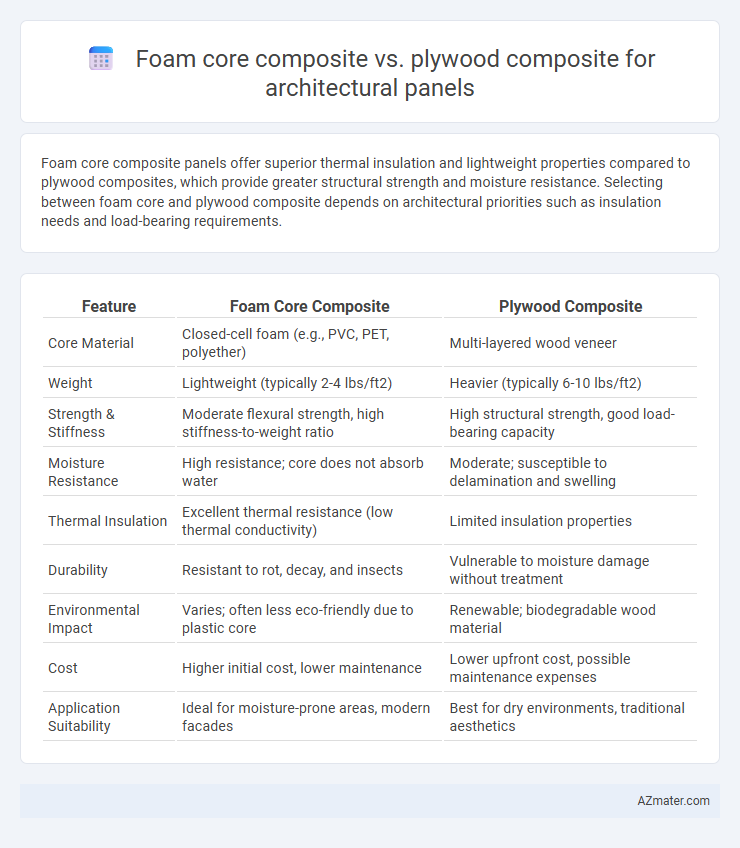Foam core composite panels offer superior thermal insulation and lightweight properties compared to plywood composites, which provide greater structural strength and moisture resistance. Selecting between foam core and plywood composite depends on architectural priorities such as insulation needs and load-bearing requirements.
Table of Comparison
| Feature | Foam Core Composite | Plywood Composite |
|---|---|---|
| Core Material | Closed-cell foam (e.g., PVC, PET, polyether) | Multi-layered wood veneer |
| Weight | Lightweight (typically 2-4 lbs/ft2) | Heavier (typically 6-10 lbs/ft2) |
| Strength & Stiffness | Moderate flexural strength, high stiffness-to-weight ratio | High structural strength, good load-bearing capacity |
| Moisture Resistance | High resistance; core does not absorb water | Moderate; susceptible to delamination and swelling |
| Thermal Insulation | Excellent thermal resistance (low thermal conductivity) | Limited insulation properties |
| Durability | Resistant to rot, decay, and insects | Vulnerable to moisture damage without treatment |
| Environmental Impact | Varies; often less eco-friendly due to plastic core | Renewable; biodegradable wood material |
| Cost | Higher initial cost, lower maintenance | Lower upfront cost, possible maintenance expenses |
| Application Suitability | Ideal for moisture-prone areas, modern facades | Best for dry environments, traditional aesthetics |
Introduction to Architectural Panel Materials
Foam core composite and plywood composite are prominent materials used in architectural panels, offering distinct advantages in construction and design applications. Foam core composites provide superior insulation properties and lightweight strength due to their cellular core sandwiched between rigid outer layers, making them ideal for energy-efficient building envelopes. In contrast, plywood composites deliver enhanced structural integrity and natural aesthetic appeal, often preferred for load-bearing applications and environments demanding durability and flexibility in finishing options.
Overview of Foam Core Composites
Foam core composites for architectural panels consist of lightweight foam sandwiched between rigid outer layers, offering superior thermal insulation and high strength-to-weight ratios compared to plywood composites. These materials provide enhanced durability, moisture resistance, and dimensional stability, making them ideal for applications requiring long-lasting performance and reduced structural load. Foam core panels also allow for greater design flexibility and easier installation, contributing to efficiency in modern architectural projects.
Overview of Plywood Composites
Plywood composites are engineered wood products made by bonding multiple layers of thin wood veneers with adhesives, providing enhanced strength, stability, and resistance to warping. They offer superior load-bearing capacity and moisture resistance compared to foam core composites, making them suitable for structural architectural panels. Due to their durability and versatility, plywood composites are widely used in applications requiring both aesthetic appeal and long-term performance.
Weight Comparison: Foam Core vs Plywood
Foam core composite panels typically weigh 40-60% less than plywood composite panels, making them ideal for applications requiring lightweight materials without compromising structural integrity. The low density of foam core materials reduces overall panel weight, enhancing ease of handling and installation in architectural projects. Plywood composites, while heavier, offer superior rigidity and impact resistance, but their increased weight can affect transportation costs and load-bearing considerations.
Strength and Durability Analysis
Foam core composites offer superior strength-to-weight ratios compared to plywood composites, making them highly suitable for architectural panels requiring lightweight structural integrity. The foam core's closed-cell structure enhances durability by resisting moisture absorption and minimizing delamination risks common in plywood composites exposed to fluctuating environmental conditions. Plywood composites, while traditionally strong, tend to suffer from reduced longevity due to their susceptibility to warping, fungal decay, and mechanical fatigue under prolonged stress.
Insulation Properties and Thermal Performance
Foam core composites offer superior insulation properties compared to plywood composites due to their low thermal conductivity and high R-values, effectively reducing heat transfer and improving energy efficiency in architectural panels. The rigid foam core acts as a thermal barrier, enhancing overall thermal performance by minimizing thermal bridging commonly found in plywood composites. Foam core panels also contribute to better indoor temperature regulation, leading to reduced heating and cooling costs in building applications.
Moisture Resistance and Weathering
Foam core composites exhibit superior moisture resistance compared to plywood composites, as the closed-cell foam core prevents water infiltration and inhibits mold growth, making them highly durable in wet environments. Plywood composites are more susceptible to swelling, delamination, and decay due to their wood fibers absorbing moisture, which compromises structural integrity over time. Exposure to weathering causes foam core composites to maintain dimensional stability and resist UV degradation better than plywood composites, which can experience warping and surface deterioration under prolonged environmental stress.
Ease of Fabrication and Installation
Foam core composites offer superior ease of fabrication due to their lightweight nature and flexibility, allowing quicker cutting, shaping, and assembly compared to plywood composites. Installation of foam core panels is faster and less labor-intensive because of their reduced weight, which minimizes handling challenges and structural support requirements. Plywood composites, while durable, often require more precise cutting tools and additional fastening efforts, making them less efficient for rapid architectural panel installation.
Sustainability and Environmental Impact
Foam core composites offer superior insulation properties and lower embodied energy compared to plywood composites, reducing energy consumption in building operations and resource extraction impacts. Plywood composites, while biodegradable and derived from renewable wood sources, involve higher deforestation risks and use adhesive resins that may off-gas volatile organic compounds (VOCs). Selecting foam core composites with recycled or bio-based cores enhances sustainability by minimizing landfill waste and improving thermal efficiency in architectural panels.
Cost Considerations and Final Recommendations
Foam core composite panels offer a lightweight and cost-effective alternative to plywood composites, reducing transportation and installation expenses significantly. Plywood composites, while generally more expensive due to raw material and manufacturing costs, provide superior strength and durability, making them suitable for higher-load architectural applications. For budget-sensitive projects prioritizing ease of handling and insulation properties, foam core composites are recommended, whereas plywood composites are preferred when structural integrity and longevity are critical.

Infographic: Foam core composite vs Plywood composite for Architectural panel
 azmater.com
azmater.com